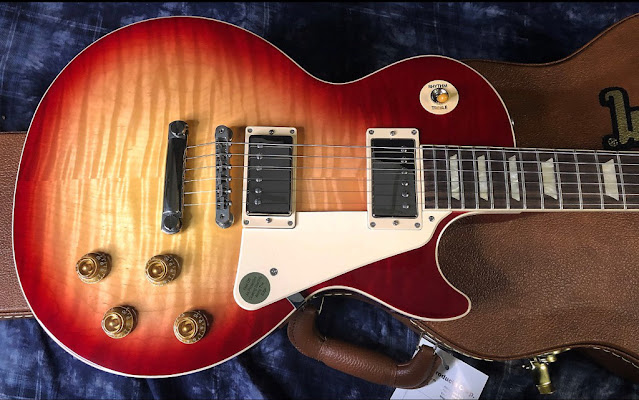Down the Rabbit Hole
So I just bought a Gibson Les Paul. If you know anything about Les Pauls, you know that that statement is not so simple because Gibson has made umpteen billion versions of the Les Paul. Deciding which one to get is a deep research project all on its own, especially when your goal is to do the impossible: Capture the vintage '59 Burst magic with a modern Les Paul on a relatively modest budget. Yes, an impossible but noble goal. And that's what led me down the rabbit hole of Les Paul lore.
And oh what a rabbit hole it is!
Let’s just say, the Internet is filled to the brim with facts, opinions, rumors, allegations, innuendo, and a whole lot of bullshit on this most hallowed of guitars.
Going down the Les Paul rabbit hole leads you into impassioned discussions about things like tenon length, pickup spacers, weight relief, headstock angles, winding patterns, neck profiles, bridge inserts, magnet types, and a bunch of other guitar nerd minutiae. When all the little details get picked apart and scrutinized like they have, the Les Paul becomes less of a guitar, and more of a formula for some magical potion. And no matter how tiny and seemingly inconsequential an element of that formula is, there is somebody on the ‘net who is absolutely convinced that it is the magic ingredient that gives a '59 Burst its mojo.
So when you're neck-deep in all the minutiae, the obvious question is:
Does all this shit really matter?
Now, that’s a hard one.
For one thing, it's impossible to devise an experiment to test the contribution of one alleged factor in the Les Paul formula that removes all the other possible factors.
Secondly, a lot of what we hear in guitars doesn't seem to be objectively measurable. I hear nuances in sound and pitch that many of my friends do not, for example, and I know that my hearing isn't nearly as sharp as many other musicians that I know. So a small difference in guitar tone might be imperceptible to one person and pretty egregious to another. And you just have to take the bat-eared person's word for it.
And that brings me to the 3rd point. Even people with exceptional ears and tons of experience with vintage Les Pauls are unreliable experts because of psychological factors like confirmation bias, effort justification, choice-supportive bias, illusory truth effect, motivated reasoning, and a million other observed behavior from humans rationalizing their choices. These psycho-phenomena are quite real and certainly more empirically-validated than most Les Paul lore. And nobody is immune to them, least of all Burst aficionados.
Finally, you have to acknowledge the vested interest that guitar makers have in promoting this fixation on construction details. How else would Gibson motivate well-heeled players to "upgrade" from the last supposedly dead-accurate reissue they bought?
All of this is a long-winded way of saying that understanding how much all these tiny details contribute to the sound of the guitar is ridiculously subjective, biased by motive, and prone to error.
That said, I have my own beliefs on this topic, mostly formed by my experiences with guitars in general. And subject to all the same human foibles.
I believe that every deviation from the formula does in fact have some tonal effect, tiny though it may be. Any one change by itself may not be a big deal – a mere rounding error in the overall sound.
But like rounding errors in mathematics, the cumulative effect from multiple changes can become significant.
If a guitar has a couple dozen or more variances from the formula, it can end up sounding quite different from the original, despite the fact that each variance seems inconsequential on its own. (Heck, the variance in sound of guitars off the same assembly line built on the same day should convince most players of this.)
So all other things being equal (which they almost never are), if I’m trying to get as close as possible to the '59 Burst sound, I’ll get closest to that ideal by following the '59 Burst formula as much as possible so that the cumulative effect of variances is minimized. I try to stick with the formula, within the (very) limited constraints of my budget and what is available on the market, deciding which elements I’ll compromise on and which ones I won't.
On the other hand, chasing the classic Les Paul sound is an exercise in sentimental romanticism. And romanticism can lead a person to reject all manner of objective reason. If you’re fixated on nailing the mythological '59 Burst sound, your basic premise is that Gibson perfected the formula in 1959. If you think about it, the notion that the past 60 years of guitar making has produced nothing of value that can improve the 1959 Les Paul formula is one hell of an assumption. It would be a phenomenally exceptional situation that defied the pattern in pretty all other areas of manufacturing.
So, yeah, I stick with the formula. But I'll just acknowledge that "sticking with the formula" comes with choices that I probably wouldn’t make if I were thinking purely objectively and not at all sentimentally.
It's impossible to go down the rabbit hole and not get any shit on your shoes.

Comments
Post a Comment